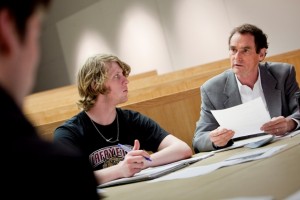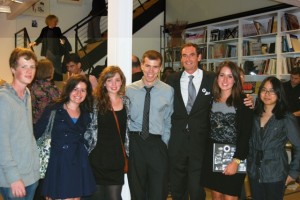
Professor Robert Mattison teaches an art history class.
Robert Mattison, Metzgar Professor of Art, understands the importance of a liberal arts education. Not only has he experienced its benefits, he is celebrating it through curating and writing the catalogue for Black Mountain College and Its Legacy. The exhibit opened at the Loretta Howard Gallery in New York City Sept. 15 and will continue through Oct. 29.
“Black Mountain College brought together painters, engineers, dancers, musicians, mathematicians, and photographers and resulted in the production of new and innovative advancements in many fields,” explains Mattison. “This exhibit ties together a bunch of what we do here at Lafayette. It fits into a liberal arts direction.”
Between 1933 and 1957, Black Mountain College in the countryside of North Carolina was one of the most important institutions in the western world to nurture modern art. While the institution taught languages, literature, mathematics, and science, the arts were a central part of the curriculum. One of the most significant parts of the Black Mountain experience was a visiting artists program, which invited cutting-edge artists in a wide range of disciplines to mentor the college’s students. Such figures included John Cage, Merce Cunningham, Buckminster Fuller, Willem de Kooning, and Robert Motherwell.

Professor Robert Mattison, center, with students at the opening of Black Mountain College and Its Legacy
“Black Mountain was a gathering point of key modern arts figures,” explains Mattison. “There has not been an exhibit about it in New York in 30 years. It is great to bring all of these pieces together and explore what happened there.”
The exhibition presents works created at Black Mountain College as well as later legacy works. It includes music, videos, poetry recordings, photographs of faculty and students, and archival material of letters and publications. The exhibition is co-curated by Loretta Howard. Several events such as dance and music performances and poetry readings will take place during the run of the exhibit.
Mattison, who received his bachelor’s in art history at Middlebury College, originally studied English literature until an inspiring new art history professor made him realize art was his passion. He went on to earn a master’s from Williams College and master’s and doctoral degrees from Princeton University. It’s the kind of transformation Mattison sees in many of his students.
“Since high school, I was interested in teaching, mostly because of the many teachers I enjoyed there,” he explains. “Since art history is not usually taught at the high school level, many students don’t realize that it might be their passion until college. This change of mind, much like the one I had, happens often at Lafayette and I enjoy seeing students evolve and grow in the field.”
Mattison has seen his students go on to work at and curate exhibits at the Metropolitan Museum of Art, the Frick Collection, the Whitney Museum of American Art, the Yale University Art Gallery, and other New York City art galleries.
“My colleagues and I strive to be inspirational teachers,” Mattison says. “In the classroom we are busy discussing art as physical, but also the politics of the time, the interests in music and films, and the history of the time period. We try to pull it all together to understand the human endeavor of the time period. I want to send my students on so that they can find a rewarding life in the field.”


1 Comment
Comments are closed.